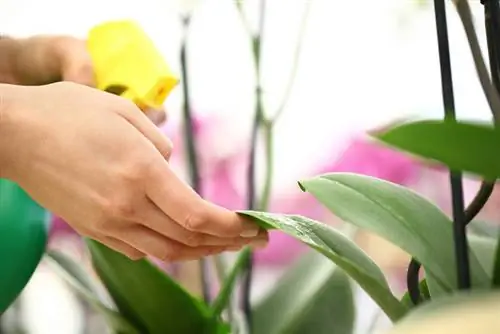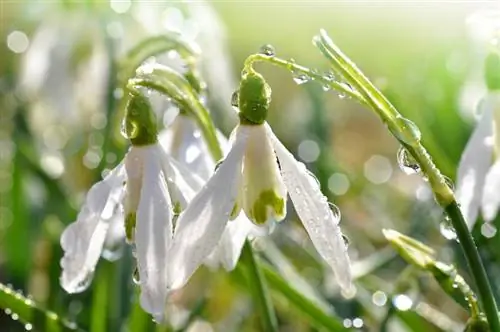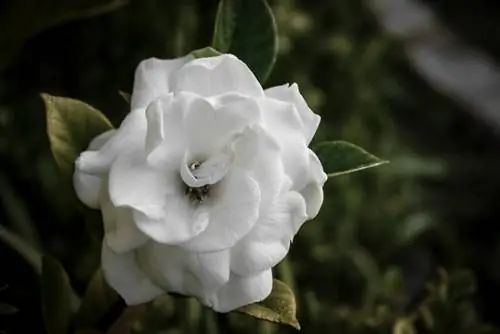- Author admin [email protected].
- Public 2023-12-16 16:46.
- Last modified 2025-01-23 11:20.
It exudes a unique orchid glow on the windowsill without taxing the gardener with capricious demands. Thanks to its uncomplicated attitude, the wonderful Phalaenopsis is the ideal orchid for beginners. These care instructions address all the important questions about successful cultivation, peppered with useful tips.

How do you properly care for orchids?
Caring for orchids properly includes balanced watering, regular fertilizing, proper cutting, repotting and suitable site conditions. Orchids such as Phalaenopsis do not tolerate waterlogging, prefer special orchid fertilizer and do not like cold or extremely sunny locations.
How do I water the orchid to the right extent?
One of the central components of well-founded care instructions is the balanced water balance of a phalaenopsis. To ensure that there is neither irreversible waterlogging nor fatal dryness, we recommend this procedure:
- Dip the pot with the aerial roots once a week in summer at temperatures of 19-25 degrees Celsius
- In winter, extend the intervals according to the reduced light and temperature conditions
- To do this, soak the root ball so that there is no water in the heart of the plant or in the leaf axils
- Alternatively, water with lime-free water whenever the substrate has dried out
Please ensure that irrigation water can always drain unhindered. Please use a special orchid planter that has a platform inside for the culture pot so that the roots are not in water. Wet leaves should be dried by the beginning of the night.
Pouring and spraying go hand in hand
If you ask an orchid expert about the most important tips for perfect water supply, he will usually point out continuous spraying. Pamper a moth orchid with a gentle mist that includes the silvery aerial roots.
Is regular fertilization part of the care plan?
In the period from April to October, a phalaenopsis gratefully accepts additional nutrients. Please add a liquid orchid fertilizer (€7.00 on Amazon) to the water every third watering or dipping. Between November and March, applying fertilizer every 6-8 weeks completely covers the requirement. Please note that conventional flower fertilizer has a s alt concentration that is far too high and is therefore completely unsuitable.
When and how should a Phalaenopsis be cut?
This question should be addressed in every guide, because no other question causes more headaches for beginners. How good that a central premise provides security for action: never cut off green parts of a moth orchid. How to prune your Phalaenopsis professionally:
- Do not cut off withered flowers, pick them off or let them fall down
- Only cut worn flower stalks when they are completely dead
- Just cut back to the green stem base with 2 to 3 buds
Phalaenopsis orchids tend to sprout again below flower stalks that have faded and continue the flower festival. As long as there is still a green stem base, please cut back to there and give the next flowers a chance.
How do I gently repot the moth orchid?
In order to repot a Phalaenopsis in an exemplary manner, you only need to look at these care instructions every 2 to 3 years. If you are at the beginning of keeping orchids, this measure will only come into focus after 5 years. The best time to change to fresh substrate and a new culture pot is spring, shortly before budding begins. The orchid should not have flowers. How to do it correctly:
- The day before, water or dip the orchid to create flexible aerial roots
- Knead the pot, grasp the plant between the leaves and root ball and carefully unpot it
- Shake off or rinse off old substrate
- Insert the root network into the new pot with a twisting motion
Fill the orchid substrate in small portions, repeatedly tapping the pot. Do not water the freshly repotted Phalaenopsis, just spray the leaves and aerial roots with soft water.
Is a phalaenopsis with yellow, limp leaves sick?
The robust orchid species is rarely affected by classic plant diseases. If the leaves take on an unhe althy color, hang limply and wrinkled, the phalaenopsis signals discomfort. This dilemma is mostly due to failures in care. We have put together the most common triggers for you here with tips on how to eliminate the error:
- A cold shock causes the leaves to become soft and limp: temperatures of 18 to 23 degrees Celsius are ideal
- The leaves become wrinkled in the rotted substrate: repot immediately in fresh orchid soil
- The leaves wilt when waterlogged: repot as soon as possible and only dive once a week
- Sunburn causes yellow, brown and spotty leaves: immediately move to a partially shaded location
If the buds turn yellow while the leaves are still lush green, your Phalaenopsis is almost certainly suffering from a lack of light or a location that is far too cold. In winter you can solve the problem with a plant lamp. In addition, avoid opening windows in the immediate vicinity to ventilate the room.
Tip
If your Phalaenopsis seems a little slow to bloom, awaken the floral spirit by significantly lowering the temperatures at night. If you place the moth orchid for 6 weeks in a place where the mercury column does not exceed 16 degrees at night, this measure will stimulate flower induction.






